Cardiales
When you spend enough time at Tupã, everything you own begins to take on the particular tone of ochre that characterizes the region’s iron-rich soil. Your clothes become stained and will likely never revert to their original color. Your shower water runs red with the clay and silt lodged in every wrinkle in your skin. Even the sheep look as though they belong to an odd, local breed, their wool tinted red and their knees, like a toddler’s, permanently dirtied.
I wish I had the gift of some writers who carry whole worlds in their imagination. So flush are they with creation that characters, lands, and languages spring as if unbidden from the edge of their conscious mind. I am merely a recorder. I write what I see when I find something beautiful. I take down conversations and events when they charm me. When they illuminate me, when they tell me something about the world. Or when they strike me as palpably real. When they exemplify goodness, or sadness, or the way things are. I will always be a naturalist, I suppose: collecting things and finding the right name for them. What follows are my records - field notes, if you will - from my summer in Tupã.
Cardiales
I’m still tired from end-of-year travel and the exhausting 10-hour drive to the fazenda. But it was up at 4:30 this morning and out to the experiment. As inevitably happens on the first day of field work, a series of mishaps followed. We couldn’t find one of the stakes that marks where to set up the tripods. And the leaves were so wet with dew that we had to forget about doing water stress measurements on the leaves and come back later. And then the truck didn’t start and we had to walk back to the fazenda for help only to find out that it was only the contact on the battery that had jiggled loose. Oh, and by now it was 11:00 in the afternoon and I still hadn’t eaten breakfast or brushed my teeth. And then the afternoon was so hot, but we went out and dug holes and took more measurements on the soybeans. I at least had a chance to take a long nap in my hammock, or just long enough before we went out again to collect the tripods and sensors for the night.
Sometimes this work seems so hard. I doubt myself more often than not. I wonder if I’m just killing myself to collect crappy data that won’t even be useable in the end. Times like this when I wish I had someone telling me what to do. Being in charge is hard.
But today I saw a cardial, a cardinal. Like the red birds I showed you on our hike in the prairie, but smaller, like a little jewel. Only the crest was red, and the belly was white and the rest of the body an ashy blue. My heart skipped a beat when I saw it. And driving back from the experiment in the evening the moon was so big it seemed impossible, as yellow as a Texas grapefruit, sitting on the horizon like a placid, fat Buddha. Looking back only a minute later it was already smaller and insignificant. And there was a dog in the trashcan, sleeping like a baby on the crushed aluminum cans and banana peels. He had jumped in to find some food and then got stuck there, I guess. When he heard me approach he tried to get out again, and I tipped the can over to help him. He made me laugh, the shameless fellow.
Such things never happen when I’m in my office. Or when I’m in the city. Or when I’m in the lab. Maybe that’s why I get bored with those things so quickly. Maybe I’m pretty lucky, after all.


